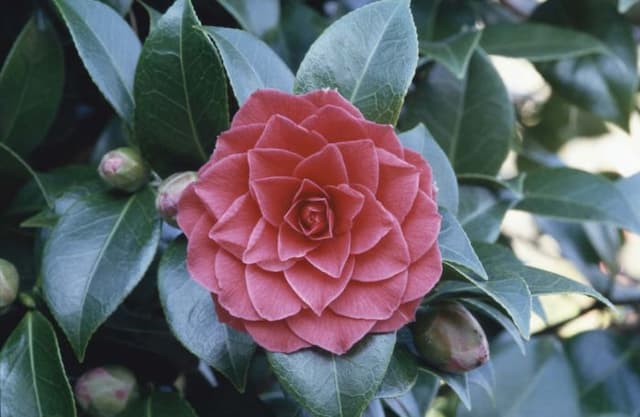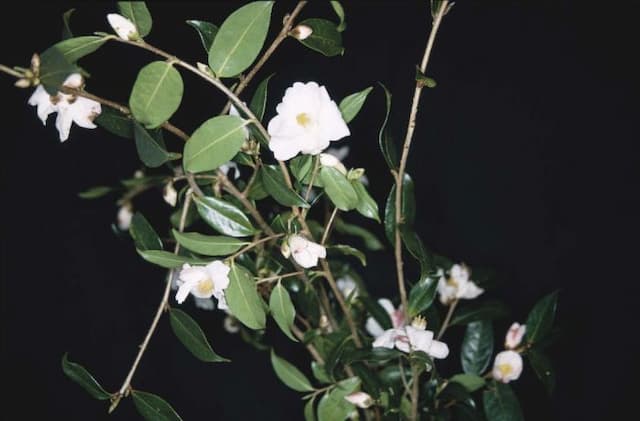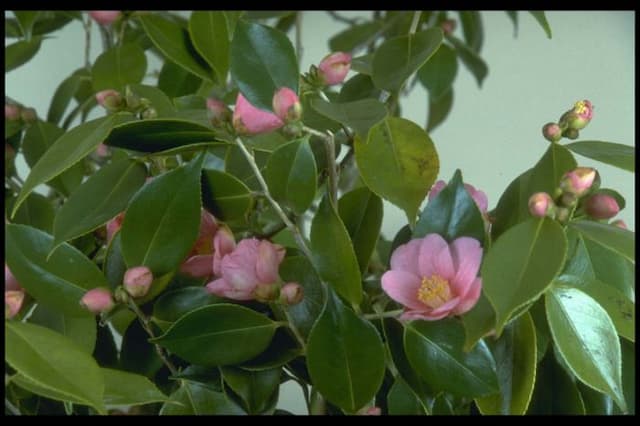Japanese Camellia Camellia japonica 'Adelina Patti'

ABOUT
The Camellia japonica 'Adelina Patti' is adorned with delicate features that make it a favorite among ornamental plants. Its signature blooms are a sight to behold, boasting an attractive blend of deep pink petals that often exhibit a beautifully arranged double form, giving them a full, opulent look. Each flower is symmetrical and well-structured, drawing the eye to its intricate layers and romantic hues. The petals have a velvety texture, contributing further to the plant’s luxurious appearance. Surrounding these stunning flowers, glossy deep green leaves create a rich backdrop that accentuates the floral display. The leaves are oval-shaped with a smooth edge, and they have a leathery aspect that gives them a robust and healthy sheen. This plant typically blooms from late winter through the spring, providing a welcome splash of color during a time when many other plants are still waking from their winter dormancy. As the seasons change, the plant remains an attractive feature due to its evergreen foliage, ensuring that it continues to add life and vibrancy to the garden throughout the year. The growth habit of the 'Adelina Patti' is orderly and dense, giving it a handsome form even when not in bloom. Its appearance is classic and elegant, often making it a beloved choice for both formal and informal garden settings.
About this plant
 Names
NamesSynonyms
Japanese Camellia, Rose Of Winter, Adelina Patti Camellia
Common names
Camellia japonica 'Adelina Patti'.
 Toxicity
ToxicityTo humans
The Japanese camellia is not considered to be toxic to humans. There are no well-documented cases of poisoning from ingesting any part of this plant. However, as with any non-food plant, individual allergic reactions or gastrointestinal discomfort could occur if ingested, but this is not common.
To pets
The Japanese camellia is also not known to be toxic to pets. This plant is not listed among those commonly known to cause poisoning in pets such as dogs and cats. Although it is not considered poisonous, it is always advisable to prevent pets from ingesting plants, as they could potentially cause mild stomach upset or an allergic reaction in sensitive individuals.
 Characteristics
CharacteristicsLife cycle
Perennials
Foliage type
Evergreen
Color of leaves
Green
Flower color
Pink
Height
6-10 feet (1.8-3 meters)
Spread
5-7 feet (1.5-2.1 meters)
Plant type
Shrub
Hardiness zones
7
Native area
Japan
Benefits
 General Benefits
General Benefits- Ornamental Value: Camellia japonica 'Adelina Patti' is widely appreciated for its large, beautiful flowers that enhance the aesthetic appeal of gardens and landscapes.
- Long Blooming Season: This variety typically has a long flowering period, providing color and interest throughout the season.
- Shade Tolerance: Camellias can grow well in partial shade, making them suitable for understory planting or north-facing gardens.
- Drought Resistance: Once established, camellias can be relatively drought-tolerant, requiring less frequent watering compared to other garden plants.
- Evergreen Foliage: As an evergreen, the Camellia japonica provides year-round greenery, maintaining garden interest even when not in bloom.
- Versatility: Suitable for a range of landscape uses including specimen planting, hedging, and container growth.
- Wildlife Attraction: The flowers can attract pollinators such as bees, adding ecological value to the garden.
- Low Maintenance: Camellias generally require minimal pruning and can be relatively easy to care for once established.
 Medical Properties
Medical Properties- This plant is not used for medical purposes.
 Air-purifying Qualities
Air-purifying QualitiesThis plant is not specifically known for air purifying qualities.
 Other Uses
Other Uses- The leaves of Camellia japonica can be used as a natural dye for fabrics, offering hues ranging from green to brown depending on the processing method.
- Wood from the camellia plant is dense and can be used in the crafting of small objects like handles, carving intricate designs or tools due to its fine grain.
- The petals of Camellia japonica can be used in the culinary arts as a decorative element for plating, adding an elegant touch to dishes.
- It serves as a natural insect repellent when the leaves are crushed and spread around outdoor living areas due to its distinct scent.
- Camellia japonica can be used in flower arranging and Ikebana, a traditional Japanese art of flower arrangement that emphasizes form, balance, and harmony.
- Petals of this plant make a colorful addition to homemade potpourri mixes, contributing fragrance and a pop of color.
- Dried leaves can be included in sachets to be placed in drawers or closets to impart a subtle, fresh scent to linens and clothing.
- The waxy leaves and flowers of Camellia japonica are sometimes used to make floral candles and soaps for their aesthetic appeal.
- Its resilient petals can be incorporated into pressed flower crafts, such as bookmarks or decorative cards, preserving their beauty.
- Camellia japonica can be grown as a bonsai, offering the challenge and aesthetic of miniaturized trees for enthusiasts.
Interesting Facts
 Feng Shui
Feng ShuiThe Camellia is not used in Feng Shui practice.
 Zodiac Sign Compitability
Zodiac Sign CompitabilityThe Camellia is not used in astrology practice.
 Plant Symbolism
Plant Symbolism- Admiration: Camellia flowers are often associated with deep admiration. The 'Adelina Patti' variety, with its beautiful blooms, signifies the admiration one may hold for another person's qualities and accomplishments.
- Perfection: With its lush, perfectly formed petals, the Camellia represents the ideal of perfection, suggesting that something or someone is being viewed as flawless.
- Longevity and Faithfulness: As Camellias are evergreen plants that can live for many years, they symbolize enduring and steadfast commitment in relationships.
- Love: In the language of flowers, Camellias often denote love, and 'Adelina Patti', with its charming and delicate appearance, may suggest a gentle and unyielding love.
- Refinement: The Camellia is frequently seen as a symbol of refinement and chastity, owing to its elegant bloom and association with well-bred gentry, particularly in cultures like Japan.
 Water
WaterJapanese Camellia should be watered deeply to ensure the soil is moist but not waterlogged. Ideally, watering should be done early in the morning, and the frequency may vary from once a week during the dry season to less often during cooler, wetter periods. Typically, 1-2 gallons of water per plant every week during the growing season should suffice, but be sure to adjust according to rainfall and soil drainage. In winter months, reduce watering to prevent root rot, especially for outdoor plants.
 Light
LightJapanese Camellia thrives in partial shade to light sun. It should be planted in a spot that receives morning sunlight but is protected from the intense, direct sunlight of the afternoon. Bright, diffused light is key for promoting vibrant blooms and ensuring the plant's health.
 Temperature
TemperatureJapanese Camellia does best in a moderate climate with temperatures ranging between 40°F and 85°F. Frost can damage the flowers and buds, so they should not be exposed to temperatures below 20°F. Ideally, maintain an environment that is consistently cool to warm, avoiding extreme temperature fluctuations.
 Pruning
PruningPruning Japanese Camellia is essential to maintain shape and promote vigorous growth. The best time to prune is right after flowering has finished, typically late winter or early spring. Remove any dead or weak wood, and thin out the plant to allow light and air to penetrate the center. Pruning is not necessary every year but should be done as needed to control size and improve the structure of the plant.
 Cleaning
CleaningAs needed
 Soil
SoilFor the Japanese Camellia, a well-draining soil mix is essential; blend equal parts peat, pine bark, and coarse sand or perlite. This plant thrives in slightly acidic soil with a pH between 5.5 and 6.5.
 Repotting
RepottingThe Japanese Camellia should be repotted every 2-3 years to encourage growth and overall health; they prefer to be somewhat root-bound.
 Humidity & Misting
Humidity & MistingJapanese Camellias flourish in moderate to high humidity levels; ideally, humidity should stay between 50-80% for optimal growth and bloom.
 Suitable locations
Suitable locationsIndoor
Ensure bright, indirect light and high humidity for indoor Japanese Camellia growth.
Outdoor
Plant in dappled shade, shelter from cold winds, mulch, and ensure soil drainage for outdoor Japanese Camellia.
Hardiness zone
7-9 USDA
 Life cycle
Life cycleThe life of the Japanese camellia, specifically the 'Adelina Patti' variety, begins with the germination of seeds planted in well-drained acidic soil, typically in the spring following a period of stratification. After germination, the seedling emerges and develops its first set of true leaves, entering a juvenile phase where it focuses on establishing a robust root system and foliage growth. As the plant matures, usually within 2 to 5 years, it enters the adult phase characterized by the development of buds and the first flowering, revealing the distinctive pink, peony-like blooms of the 'Adelina Patti' cultivar. Following pollination, the flowers give way to seed pods that, once mature, release seeds to start a new generation. In addition to sexual reproduction, the Japanese camellia can also be propagated vegetatively through cuttings, which will produce a mature flowering plant more quickly than seed propagation. Throughout its life, which can span over 100 years if conditions are favorable, the Camellia japonica 'Adelina Patti' requires pruning to maintain shape and promote healthy growth and flowering.
 Propogation
PropogationPropogation time
Late winter to early spring
The Camellia japonica 'Adelina Patti', commonly known as the Camellia, is typically propagated during the plant's dormant season, which is late fall to early spring. However, the most popular method of propagation is by semi-hardwood cuttings taken in late summer. Start by selecting healthy, non-flowering shoots of the current season's growth. Cuttings should be 4 to 6 inches long (about 10 to 15 centimeters) and include at least two to three sets of leaves. Dip the cut end into rooting hormone powder to encourage root development and plant the cutting into a well-draining potting mix. Maintain a humid environment with consistent moisture and temperature, keeping the cuttings out of direct sunlight until they root, which generally takes a few months. Once rooted, the young camellias can be transferred to individual pots and eventually planted out into the garden.









